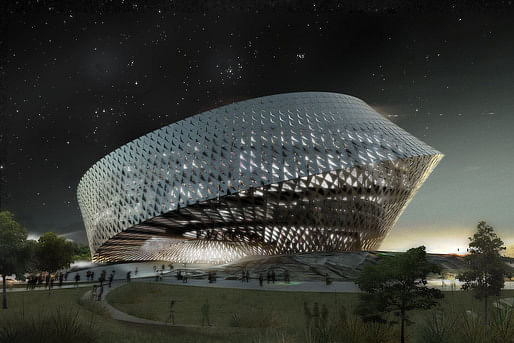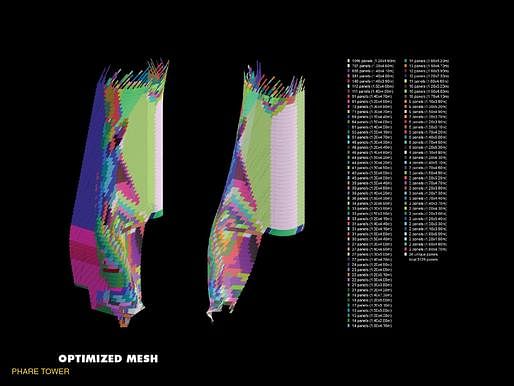

I have been researching optimization methods in architecture and I was delighted to learn about a few high profile projects that have utilized some fantastic algorithms to assist in the realization of complex forms.
Multi-Objective Optimization or Multi-Criteria Design Optimization (MCDA) software has been developed primarily for and by industrial engineers to design airplanes, automobiles, high speed trains and appliances. Process Integrated Design Optimization is another name for the field. The idea of optimization in architecture has been around since nearly the beginning of CAD in the 1950s and 60s, but had been limited by the power of computers and the huge number of variables so it has not yet achieved a critical mass of proponents. The drive towards BIM technology has been justified in part because of benefits that result from having a digital representation of the building to develop performance simulations.
Designers who work with MCDA craft search spaces, and guide searches with goal sets. In Galapagos, the in-house evolutionary solver for Grasshopper (the parametric modeling plugin for Rhino) there are two inputs, genomes and a fitness function. Genomes represent variables that can be changed in order to manipulate a model. A fitness parameter is a 'score' that the solver wants to target.
It is essentially a matter of measuring something, changing a variable in the experiment, measuring again, and guiding the changes in the model towards the desired score. Of course this process is automated and guided by optimization algorithms, genetic algorithms are frequently used, Richard Dawkins seminal book, The Selfish Gene outlines many of the principles still used in this process including mutations, crossovers and population size parameters that I will describe later.
Recently, projects at the Stanford Center for Facilities Engineering have advanced the interest in architectural application by integration with these new process engineering software systems. Digital Project (CATIA) can be integrated directly to the Phoenix Integration Model Center interface, there does not yet exist a publicly available wrapper for Grasshopper/Rhino. Skidmore, Owings and Merrill used the DP>ModelCenter workflow for fine tuning the structural system for their TransBay Terminal Tower proposal.

Other projects that have used optimization in the recent past include OMA for their new Hong Kong transit project, FTW's Water Cube (the structure was rationalized using optimization) and many other projects consulted on by ARUP, who have developed a promising integration software, DesignLink.

The video below by engineers at Ramboll shows how the mobius strip form of the Astana Library was engineered to maintain the ideal form, minimize deflections, panel variations, cost and material usage to make the project a reality. A similar but less sophisticated process was used in the Morphosis Phare Tower in Paris :

With more design phase models representing a realistic model of what the built construction will be, simulations are increasing in popularity as benchmarks for making design decisions. The legal issues concerning liability in the use of these figures is bound to become a hot topic as the tools become seamlessly incorporated into design software environments. Autodesk Revit incorporated an Analyze tab in Revit 2010, providing solar radiation and energy analysis through Green Building Studio. Vasari now has computer fluid dynamic (CFD) simulation, though it is based on a video game engine and is not highly accurate as programs like CFDesign or Fluent which can provide good analysis of passive ventilation strategies.
When I worked with Autodesk last summer there was a big push for optimization procedures with three projects in the IDEA studio (the university-tied research wing of Autodesk) directly supporting this study. The projects were Local Code, Nicholas de Monchaux, a project by David Benjamin of The Living, structural optimization of the Living Light pavillion in Korea is linked below. Benjamin's studio at GSAPP has produced a great deal of experimentation with ModeFrontier, a multi-objective optimization tool and a third team of PhD researchers from USC adapting the Revit API for volumetric optimization.
Additionally, Zach Kron of the great blog buildz has developed a Goal Finder the the Vasari interface, which is enabled through the Python (a programming language) plug-in for Vasari. Vasari, if you don't know, is an Autodesk Labs product (free, for now!) that allows you do perform conceptual design studies and load them directly into Revit.
I have been experimenting with Grasshopper, Python, Rhino and Phoenix Integration to create 'search space' models that allow a designer to provide a framework for manipulation that is guided by goal sets. I have been working on 'goal sets', algorithms that are inspired by shape grammar and architectural manifestos to generate many design schemes, evaluating each and providing a catalog of design options for the architect/client to choose from. A quick project that I worked on a few weeks ago codified Corbusier's design aesthetic in Towards a New Architecture, The Problem of the House into a goal set. I then created a grid based model and generated a massive family of Villa Savoyes, an early video is linked below for your perusal.
Will post much more as my thesis comes to a close (37 days)

The solving process for Poly House 001 showing convergence on a desired organization.
Architecture Research Lab specializes in design and construction technology and is located in Berkeley, California - www.archresearchlab.com



9 Comments
This sound like chinese to me. Never heard of all these applications, its like an other dimension^^
Multi-Objective Optimization or Multi-Criteria Design Optimization (MCDA) software has been developed primarily for and by industrial engineers to design airplanes, automobiles, high speed trains and appliances. Process Integrated Design Optimization is another name for the field. The idea of optimization in architecture has been around since nearly the beginning of CAD in the 1950s and 60s, but had been limited by the power of computers and the huge number of variables so it has not yet achieved a critical mass of proponents. The drive towards BIM technology has been justified in part because of benefits that result from having a digital representation of the building to develop performance simulations.
Designers who work with MCDA craft search spaces, and guide searches with goal sets. In Galapagos, the in-house evolutionary solver for Grasshopper (the parametric modeling plugin for Rhino) there are two inputs, genomes and a fitness function. Genomes represent variables that can be changed in order to manipulate a model. A fitness parameter is a 'score' that the solver wants to target.
It is essentially a matter of measuring something, changing a variable in the experiment, measuring again, and guiding the changes in the model towards the desired score. Of course this process is automated and guided by optimization algorithms, genetic algorithms are frequently used, Richard Dawkins seminal book, The Selfish Gene outlines many of the principles still used in this process including mutations, crossovers and population size parameters that I will describe later.
Recently, projects at the Stanford Center for Facilities Engineering have advanced the interest in architectural application by integration with these new process engineering software systems. Digital Project (CATIA) can be integrated directly to the Phoenix Integration Model Center interface, there does not yet exist a publicly available wrapper for Grasshopper/Rhino.
Other projects that have used optimization in the recent past include OMA for their new Hong Kong transit project, Herzog and de Meuron's Water Cube (the structure was rationalized using optimization) and many other projects consulted on by ARUP, who have developed a promising integration software, DesignLink.
Listen ; I tried my best to show the potential of something never seen before right here, in this fora --- a new way to build anything 3dh I called it. Forget about presaving these .... about new idears instead read the tread "Hi all you fancy graphics lovers", and you will know why the jobs go to china.
2004 was the year the chinese published 3dh, read the tread I mention above to know how 3dh was welcomed here.
Per, this thread? I don't have time to search around much but if you do have a precedent system that you have developed and that has been documented/published I would love to reference it in my work.
not important to the discussion at hand but herzog and demeuron didn't design the watercube. it was ptw.. herzog and demeuron did the stadium next to it.
bring on the surfaces....again
Hi Micael, jyst search "Hi all you fancy graphics lovers", Yhat is just one of many treads around this idea, concept or what to call a genuiene attemt I made back then listening to the architects at the acadamy here in copenhagen. What they expected was a "magic tool" that could deliver what the engineer would add the design -- the structure, foundations , the basic building core.. I was alloved to use the acadamy with all the workshops and hardware bexaurse I maneaged something they found very valuable, for four years where the acadamy hoped I would sucribe as student, but after that, I were allowed into the States workshops for art, where I fulfilled a number of design tools, all around boatssbuilding, as with that I had a testbench for the applications --- if the boat could be build, the software was allright. But most of these small vessels were quite tradisional build and at the end I realised what both architecture and boatsbuilding needed. At that point I were a registrated app. develober on AutoCAD platform.
Anyway if you model a house or a boat it will be a complex solid, there will be a need for walls and floors in the right thickness, and not the mosel as a shell. Becaurse when the model are "real" a program can generate the structure, by calculating the "dead" volumes, this is what 3dh do in a very simple way. The result are a framework that work in a very surprising way, --- years after I had the furious discussions here, 3dh structurees turned up everywhere I I started to ask my credits. Today many of the oppoments here, realise 3dh realy work --- I agrea it need a few small additiens such as a universal overlapslot fitting, but NASA agreaed that 3dh would be suited for "small sports and commersial aeroplane fuselages". Still it was develobed with boats as testbench, replacing the ships ribs so a much better honeycomb structure would replace the difficult ribs and bulkheads. Why there were so fierce a resistancee, here, you can ask ; I never understood why a brilliant never before seen attitude would meet so harsh a response. And that reaction made my progress with 3dh to a halt. But still the chinese published a 5000 word and 5 image paper in a architecture magazin in english and chinese.
2003 that was, but at that time I had been promoting 3dh for many years.
Perc:
Do you have the scan for the chinese magazine you menditoned above?
Block this user
Are you sure you want to block this user and hide all related comments throughout the site?
Archinect
This is your first comment on Archinect. Your comment will be visible once approved.